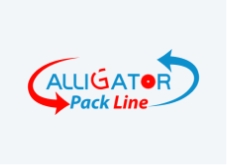How Material Handling Conveyors Improve Efficiency in Warehousing

E-commerce keeps growing, and with it, the pressure on warehouses to ship more with the same footprint. In most facilities, order picking still eats a big share of operating cost, and a lot of that time is simply walking.
At the same time, transportation and warehousing remain among the higher-risk sectors for recordable injuries, much of it linked to manual handling. Put those together, and the case for automated material handling conveyors is clear: less walking, fewer touches, steadier flow, and a safer floor.
What We Mean by “Material Handling Conveyors”
In secondary packaging, we’re moving cases, totes, trays, and unitized loads between steps like receiving, verification, buffering, sortation, and pallet packing.
We’re not filling, sealing, or labeling individual products. The job here is to keep outer packs flowing with predictable speed and spacing so downstream equipment stays fed and operators aren’t chasing work.
About 55% of warehouse operating costs come from order picking. Automating how cases and totes move is the fastest way to shrink it.
Why MDR ZPA Is the New Default
Modern motor-driven roller (MDR) conveyors with zero-pressure accumulation (ZPA) have become the standard backbone for warehouse conveyor systems. Each conveyor zone has its own low-voltage motor and sensor. Zones wake up when a load arrives and sleep when empty. That simple idea delivers three big wins:
- Energy that scales with actual work: Run-on-demand zones often cut conveyor energy by 30–50% compared with lines that run continuously. In short, you’re not paying to spin idle rollers.
- Gentle accumulation: ZPA keeps gaps without back-pressure, so cases don’t bump, scuff, or accordion. That means less rework and more reliable scanning, weighing, and sorting.
- Modular uptime: If a zone faults, the rest of the line keeps moving. Swap a motor-roller, plug in a spare, and you’re back in minutes.
Where Does the Efficiency Show Up?
Think in terms of travel, flow, and touches:
- Travel: Conveyors bridge the long walks between work areas. Every meter of travel removed from a picker or operator pays you back in minutes, cycle time, and fatigue avoided.
- Flow: Accumulation before merges and before pallet packing absorbs upstream spikes. Metered release holds the pace you set, which keeps patterns and layers consistent at the palletizer.
- Touches: With totes and cases moving automatically, you remove unnecessary lifts and carries. Fewer manual moves mean lower exposure to overexertion and awkward posture injuries.
Designing the Right Secondary-Packaging Conveyor
Good conveyor design feels “boring” in the best way possible —steady, quiet, and predictable. To get there, focus on the details:
- Zone sizing: Set zone lengths to your longest case or tote with a buffer margin. Too short and you’ll bridge sensors; too long and you waste accumulation capacity.
- Speed and gaps: Use recipe-driven setpoints for line speed and release logic. Match them to your peak-hour throughput and pallet patterns.
- Merge strategy: If you merge two or more lines, add pre-merge accumulation and release by slot to prevent blocking.
- Controls: Standardize on diagnostics you can understand at a glance, per-zone fault codes, heartbeat status, and manual jog from the HMI.
- Surfaces and rollers: Choose roller coverings and belt materials for your load range and carton finish. High-friction covers help with singulation; low-friction is better for accumulation.
- Noise and safety: Low-voltage MDR keeps noise down and narrows your lockout/tagout scope. Guard the pinch points, keep paths clear, and you’ll feel the difference on the floor.
When to Mix in Other Conveyor Types?
An automated conveyor handles most horizontal moves and accumulation. Add specialty sections only where the physics demand it:
- Inclines or declines for elevation changes.
- Belt-over-roller where small footprints need positive drive.
- Transfers and right angles for compact sort and lane changes.
The rule of thumb: keep it MDR wherever you can, and keep specialty sections short.
Alligator Automation’s Roller Conveyor System
Alligator Automations builds roller conveyor systems for secondary packaging lines where consistency is critical.
- Recipe-ready controls: Speed, gap, and release logic set from the HMI to match your takt time and pallet patterns.
- Modular frames: Quick-swap motor-rollers and plug-and-play sensors keep MTTR low and uptime high.
- Clean integration: Turnkey handshakes to case handling, dimensioning, checkweighing, sortation, and palletizing so the whole cell runs as one system.
- Energy-smart design: Zones sleep when empty and wake on demand, trimming kWh without sacrificing throughput.
If you’re planning a greenfield line or shoring up a brownfield plant, Alligator Automations maps the flow, sizes the zones, builds the buffers, and commissions the controls so day one feels stable, not like a science project.
Conclusion
If your team is still moving outer packs by hand across long aisles or fighting jams and starved machines, material handling conveyors built on MDR ZPA will cut travel, hold a steady pace, and reduce touch points. The result is faster cycles per shift, lower energy per shipped unit, and a calmer, safer floor.
Let’s design a line you can trust.
Alligator Automations delivers the entire packing and bagging line for secondary packaging, from infeed conveyance and accumulation through case handling, verification, sortation, and pallet packing, as one integrated system.
Tell us your throughput target and building constraints, and we’ll turn that into a conveyor blueprint with a clear ROI.
FAQs
1) How do material handling conveyors improve warehouse efficiency?
They cut walking by bridging work areas, keep steady gaps with accumulation, and remove non-value-add touches. That lifts throughput and smooths day-to-day operations.
2) What types of conveyors work best in secondary packaging?
Use MDR ZPA for most moves and buffering. Add short runs of belt-over-roller, inclines or declines, or transfers only where needed.
3) Are MDR conveyors energy efficient?
Yes. Because zones run only when loaded, facilities often see 30–50% less conveyor energy versus lines that run continuously.
4) Will this work in a brownfield plant?
Absolutely. Start with the long hauls and pre-pallet buffers for quick wins, then phase into merges and induction as budgets allow.
5) How does Alligator support after go-live?
Standardized spares, clear diagnostics, and remote support keep you running. Most components swap in minutes, not hours.



